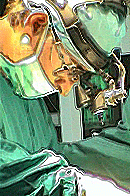Angiography in Gliomas.
 Cerebral angiography was once
an important diagnostic modality that provided preoperative
diagnosis and localization of an intracranial tumor. In the
case of deep tumors, angiography also provided a map of the
superficial cortical veins, enabling the surgeon to determine
where to incise the brain to reach the tumor. This is no longer
necessary. Today, CT and MRI provide preoperative tumor
evaluation, and intraoperative ultrasound is used at the time of
surgery for accurate localization of deep masses and for
determining the best surgical approach through the brain. In
addition, intraoperative ultrasound can also help the
neurosurgeon monitor the extent of resection during surgery.
Cerebral angiography was once
an important diagnostic modality that provided preoperative
diagnosis and localization of an intracranial tumor. In the
case of deep tumors, angiography also provided a map of the
superficial cortical veins, enabling the surgeon to determine
where to incise the brain to reach the tumor. This is no longer
necessary. Today, CT and MRI provide preoperative tumor
evaluation, and intraoperative ultrasound is used at the time of
surgery for accurate localization of deep masses and for
determining the best surgical approach through the brain. In
addition, intraoperative ultrasound can also help the
neurosurgeon monitor the extent of resection during surgery.
Despite modern neuroimaging
techniques, a few indications remain for preoperative cerebral
angiography in evaluating cerebral tumors. A well-localized,
rounded, enhancing tumor mass may require differentiation from a
giant aneurysm. In the overwhelming majority of instances, this
distinction can be made using appropriate MR techniques to
demonstrate the presence of hemosiderin-laden clot within the
mass and, with MR angiography, to demonstrate flow within the
patent portion of the aneurysm cavity. However, in some cases
the MRI and MRA findings are equivocal, and angiography is
necessary. A giant aneurysm at angiography appears as a small
aneurysm that projects into the large mass and only partially
fills it.
Occasionally, cerebral
angiography is needed to distinguish between a superficial
intra-axial cerebral mass and an extra-axial tumor such as a meningioma.
Differentiation between intra-axial and extra-axial tumors is
almost always positively established using MRI. However, it
happens, that a handful of cases in
which this distinction was not possible using the MRI studies
alone. In these cases, angiography can determine the
compartmental localization of the tumor mass by demonstrating
the blood supply. Meningiomas are fed by dural arteries. Within
the tumor, a characteristic "sunburst" or "spoke-wheellike"
pattern of feeding vessels is seen. The tumor stain is intense,
appears late in the arterial phase, and persists well into the
venous phase. No early draining veins are seen. Intra-axial
masses, on the other hand, will show a pial blood supply and the
cortical vessels will be stretched around the lateral aspect of
the mass rather than displaced inward from the inner table of
the skull.
Angiography of gliomas is
nonspecific. Many gliomas, especially those of lower grade, are
hypovascular and are only seen as avascular or hypovascular
areas surrounded by displaced normal vessels. Higher-grade
gliomas may show intense tumor neovascularity in a disorganized
pattern, a prominent tumor blush in the mid-arterial phase,
arteriovenous shunting with early draining veins, and
hypovascular areas representing necrosis or cysts.
These characteristics do not permit differentiation of a
primary glioblastoma from a metastasis and do not provide
information on the tumor histology, grade, or extent. These
determinations are all made much more easily and more accurately
by CT or MR imaging.
The distinction between an
arteriovenous malformation and a tumor is unequivocal with MRI.
The flow within the abnormal vessels of an arteriovenous
malformation together with the prominent arterial feeders and
the large draining veins are well shown on MRI and MRA, making
angiography unnecessary.



